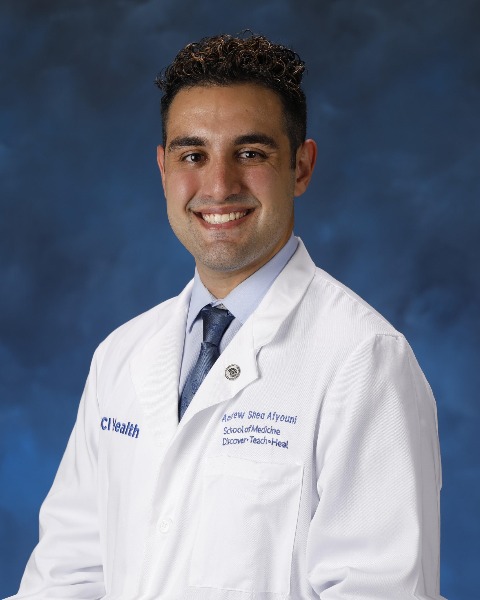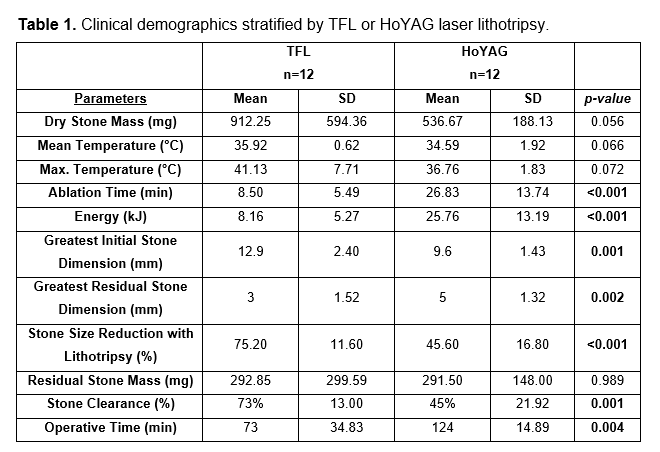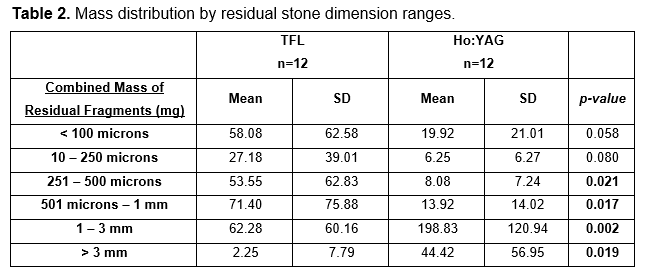Back
Poster, Podium & Video Sessions
Podium
PD19: Stone Disease: Surgical Therapy (including ESWL) II
PD19-02: Comparison of Superpulse Thulium Fiber Laser vs. Holmium Laser for Ablation of Renal Calculi in an In Vivo Porcine Model
Saturday, May 14, 2022
7:10 AM – 7:20 AM
Location: Room 245
Andrew Afyouni*, Zhamshid Okhunov, Pengbo Jiang, Sohrab Ali, Hosseini Sharifi, Linda Huynh, Nina Kar, Douglas Schneider, Maged Ayad, Krista Larson, Roshan Patel, Jaime Landman, Ralph Clayman, Orange, CA

Andrew Shea Afyouni, BS
University of California Irvine School of Medicine
Podium Presenter(s)
Introduction: The ability of laser lithotripsy to render renal calculi into passable “dust” is essential to the success of ureteroscopic stone therapy. Herein we evaluated the fragment size produced by a superpulse thulium fiber laser (sTFL) and a holmium laser (Ho:YAG) in an in-vivo porcine urolithiasis model.
Methods: Twenty-four kidneys from 12 juvenile female Yorkshire pigs were randomized to receive either Ho:YAG or sTFL treatment. Pre-weighed and pre-measured canine calcium oxalate stones were placed into each renal pelvis by a pyelotomy. A 14 French, 35 cm ureteral access sheath was placed. Using a dual lumen flexible ureteroscope (Richard Wolf Inc.), kidneys were randomized to lithotripsy with either a Ho:YAG 272µm laser fiber at 16W (0.4J, 40Hz) or sTFL 200µm laser fiber at 16W (0.2J, 80 Hz). Lithotripsy was continued until no fragments over 1mm were observed by the surgeons (ZO, PJ). Temperature was measured with two K-type thermocouples positioned percutaneously: one within the upper pole calyx and the other within the renal pelvis. No stone basketing was performed. Kidneys were bivalved and residual fragments were dried, weighed, and sieved.
Results: Initial dry-stone mass and collecting system temperatures (all < 44ºC) were similar for both lasers. Compared to Ho:YAG, stones treated with sTFL lithotripsy were ablated three times faster (9 min vs. 27 min; p<0.001), with three-fold less energy expenditure (8 kJ vs. 26 kJ; p<0.001) and 1.6 times higher stone clearance rate (73% vs. 45%; p=0.001). With sTFL, the operative time was 70% faster (73 min vs. 124 min; p=0.004) (Table 1). After sTFL, 77% of the remaining fragments were = 1mm while only 14% of fragments were = 1mm following Ho:YAG treatment (p < 0.001) (Table 2).
Conclusions: In an in-vivo porcine model with calcium oxalate stones, sTFL lithotripsy resulted in greater stone clearance, markedly smaller stone fragments, and shorter ablation time than Ho:YAG lithotripsy.
Source of Funding: None


Methods: Twenty-four kidneys from 12 juvenile female Yorkshire pigs were randomized to receive either Ho:YAG or sTFL treatment. Pre-weighed and pre-measured canine calcium oxalate stones were placed into each renal pelvis by a pyelotomy. A 14 French, 35 cm ureteral access sheath was placed. Using a dual lumen flexible ureteroscope (Richard Wolf Inc.), kidneys were randomized to lithotripsy with either a Ho:YAG 272µm laser fiber at 16W (0.4J, 40Hz) or sTFL 200µm laser fiber at 16W (0.2J, 80 Hz). Lithotripsy was continued until no fragments over 1mm were observed by the surgeons (ZO, PJ). Temperature was measured with two K-type thermocouples positioned percutaneously: one within the upper pole calyx and the other within the renal pelvis. No stone basketing was performed. Kidneys were bivalved and residual fragments were dried, weighed, and sieved.
Results: Initial dry-stone mass and collecting system temperatures (all < 44ºC) were similar for both lasers. Compared to Ho:YAG, stones treated with sTFL lithotripsy were ablated three times faster (9 min vs. 27 min; p<0.001), with three-fold less energy expenditure (8 kJ vs. 26 kJ; p<0.001) and 1.6 times higher stone clearance rate (73% vs. 45%; p=0.001). With sTFL, the operative time was 70% faster (73 min vs. 124 min; p=0.004) (Table 1). After sTFL, 77% of the remaining fragments were = 1mm while only 14% of fragments were = 1mm following Ho:YAG treatment (p < 0.001) (Table 2).
Conclusions: In an in-vivo porcine model with calcium oxalate stones, sTFL lithotripsy resulted in greater stone clearance, markedly smaller stone fragments, and shorter ablation time than Ho:YAG lithotripsy.
Source of Funding: None



.jpg)
.jpg)